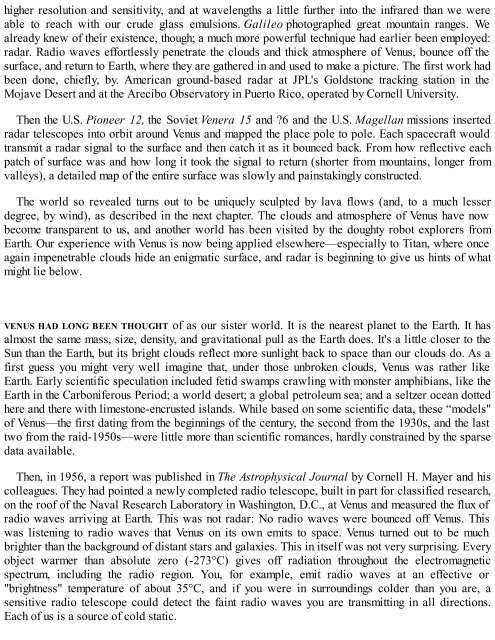Pale Blue Dot ( PDFDrive.com ) (1)
You also want an ePaper? Increase the reach of your titles
YUMPU automatically turns print PDFs into web optimized ePapers that Google loves.
higher resolution and sensitivity, and at wavelengths a little further into the infrared than we were<br />
able to reach with our crude glass emulsions. Galileo photographed great mountain ranges. We<br />
already knew of their existence, though; a much more powerful technique had earlier been employed:<br />
radar. Radio waves effortlessly penetrate the clouds and thick atmosphere of Venus, bounce off the<br />
surface, and return to Earth, where they are gathered in and used to make a picture. The first work had<br />
been done, chiefly, by. American ground-based radar at JPL's Goldstone tracking station in the<br />
Mojave Desert and at the Arecibo Observatory in Puerto Rico, operated by Cornell University.<br />
Then the U.S. Pioneer 12, the Soviet Venera 15 and ?6 and the U.S. Magellan missions inserted<br />
radar telescopes into orbit around Venus and mapped the place pole to pole. Each spacecraft would<br />
transmit a radar signal to the surface and then catch it as it bounced back. From how reflective each<br />
patch of surface was and how long it took the signal to return (shorter from mountains, longer from<br />
valleys), a detailed map of the entire surface was slowly and painstakingly constructed.<br />
The world so revealed turns out to be uniquely sculpted by lava flows (and, to a much lesser<br />
degree, by wind), as described in the next chapter. The clouds and atmosphere of Venus have now<br />
be<strong>com</strong>e transparent to us, and another world has been visited by the doughty robot explorers from<br />
Earth. Our experience with Venus is now being applied elsewhere—especially to Titan, where once<br />
again impenetrable clouds hide an enigmatic surface, and radar is beginning to give us hints of what<br />
might lie below.<br />
VENUS HAD LONG BEEN THOUGHT of as our sister world. It is the nearest planet to the Earth. It has<br />
almost the same mass, size, density, and gravitational pull as the Earth does. It's a little closer to the<br />
Sun than the Earth, but its bright clouds reflect more sunlight back to space than our clouds do. As a<br />
first guess you might very well imagine that, under those unbroken clouds, Venus was rather like<br />
Earth. Early scientific speculation included fetid swamps crawling with monster amphibians, like the<br />
Earth in the Carboniferous Period; a world desert; a global petroleum sea; and a seltzer ocean dotted<br />
here and there with limestone-encrusted islands. While based on some scientific data, these “models"<br />
of Venus—the first dating from the beginnings of the century, the second from the 1930s, and the last<br />
two from the raid-1950s—were little more than scientific romances, hardly constrained by the sparse<br />
data available.<br />
Then, in 1956, a report was published in The Astrophysical Journal by Cornell H. Mayer and his<br />
colleagues. They had pointed a newly <strong>com</strong>pleted radio telescope, built in part for classified research,<br />
on the roof of the Naval Research Laboratory in Washington, D.C., at Venus and measured the flux of<br />
radio waves arriving at Earth. This was not radar: No radio waves were bounced off Venus. This<br />
was listening to radio waves that Venus on its own emits to space. Venus turned out to be much<br />
brighter than the background of distant stars and galaxies. This in itself was not very surprising. Every<br />
object warmer than absolute zero (-273°C) gives off radiation throughout the electromagnetic<br />
spectrum, including the radio region. You, for example, emit radio waves at an effective or<br />
"brightness" temperature of about 35°C, and if you were in surroundings colder than you are, a<br />
sensitive radio telescope could detect the faint radio waves you are transmitting in all directions.<br />
Each of us is a source of cold static.


